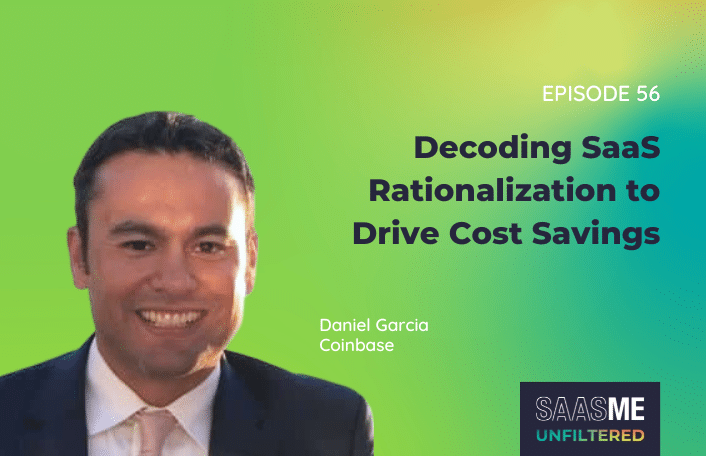04/11/2024
Table of Contents
How many applications, redundancies, and duplicative tools are in your stack? The sprawl and inefficiency is real, and the opportunity to optimize is massive. In this episode, learn how IT procurement and software asset management expert Daniel Garcia uses SaaS app rationalization as a key lever in Coinbase’s cost reduction strategies. Discover how to align your sourcing approach with organizational outcomes and leverage data-driven decisions to optimize your software stack.
Listen to the full episode on Spotify and Apple Podcasts.
Episode Summary
Application rationalization is extremely impactful to your business, yet it’s also one of the most difficult to execute. According to Daniel Garcia who leads IT Sourcing at Coinbase, you can be strategic about it if you have the right data.
“I always look at data to drive decisions, “said Garcia. “If we can get our hands around data… more often than not, you get to the decision that you’re intended to get to.”
It starts by understanding your users, what tools they’re using, and how they’re using them.
Garcia and his team use that data to empower their application portfolio managers, “making sure they have the data that really validates their assumptions and what their strategies are.”
To be successful, Garcia emphasizes prioritizing rationalization opportunities by business impact, regularly monitoring your SaaS portfolio, and going after low-hanging fruit.
Guest Spotlight
Name: Daniel Garcia
What he does: IT Sourcing and SAM at Coinbase
Connect with Daniel online: LinkedIn
Episode Highlights
Sourcing Teams Are Key to Driving Business Value
“Being in sourcing, you’re always a value add to the company, because you can bring a lot of opportunities and efficiencies. And sometimes that’s cost savings or giving money back to the business to do more. But then when times are difficult, you’re even that much more of a value add. You’re front and center where the teams are looking for you to really help support them in meeting what their challenges are on their business side, if that’s a budget or whatnot. So really getting up in front and getting an opportunity to present a lot of the opportunities and getting buy-in early on really drives for alignment, so that when you’re making tough decisions, everyone’s on board with that.”
Data Drives Rationalization Decisions
“I always look at data to drive decisions. If we can get our hands around data, then that’s going to be able to present our teams with all the ammunition that they need. And if I give them that ammunition and I give them that data, more often than not, you get to the decision that you’re intended to get to. And so that for us, remarkably, it really started with Zylo and I could get into Zylo and get all the data that I needed. And we were operating in a really short timeline, so I didn’t have a whole lot of time to go in different systems and ping different people and get all that information. I was really reliant that it was all in a central location and I could easily digest it.
Daniel’s Quadrant Approach to Prioritizing Application Rationalization Opportunities
“Once you digest [the data] it’s like, ‘Okay, how do I quadrant this?’ I think there’s a whole bunch of different ways of how you could come up with different quadrants. For us, one was governance, apps we thought there was rationalization or that we wanted to put a little bit more management behind, we’d bucket our apps in there.
We’d bucket another group of apps in what we call strategic partners. These are the apps that they’re not going to go away and that you’re going to have to have really direct negotiations with. Then we had a bucket of apps that fell under IT for some reason, but no one knew what they were or there was no ownership. We knew, if those weren’t in the right ownership spot, we had to hand those back to the business, because if they owned it they would have the best view of really what the strategic direction is or the best licensing position might be.
And then last but not least would be a bucket [of what] we know we can just optimize. The contract is based on license utilization, so if we manage these, we can optimize and we can make sure that we’re getting best value for the licenses that we’re using. Putting that together and putting that in front of all the various stakeholders and showing them the data behind it, we all were on this common goal. So it was kind of an easy conversation in that sense of where the alignment was and where the opportunity was.”
Managing SaaS Requires A Different Approach from On-Premises Software
“Talking about legacy SAM and how we’re managing SaaS, we’re kind of converging this together. Which goes into being very focused on a lifecycle management process around how do we intake the software, how do we make sure that that’s being categorized correctly from that perspective, how are we managing it? For example, we just signed an ELA. Now I know I don’t have to be in an optimization position for that software. And then I’m just going to put an earmark in 90 days with that notification that I need to now go and renew it – versus a software that we couldn’t get to an ELA, for whatever reason, so now we’re going to want to manage it.
It’s putting business rules around, monthly, quarterly, whatever that cadence is, we are going to want to go do a check and then we are going to want to go see if there’s optimization opportunities. It’s really looking at that overall process. Then you see that and you say, ‘Well, that’s not really scalable. If I have a whole bunch of software trying to optimize every single one of them, the amount of legwork that takes, and then more importantly, the amount of times I’m pinging the same user, the same question, like, ‘Hey, do you still use this software?’ Then tomorrow, ‘Do you still use this software?’’ They’re going to be immune to it and they’re not going to respond to me after a certain point. So it’s being strategic around how we envision that overall process so that we can see that we are looking at the ones that we’re managing, but building that automation…
[With SaaS], it feels like it puts more admin in the middle, where in the old world it was kind of true-ups. You let the software just extrapolate in the environment and then do the true-up at the end, and then kind of hope and pray how you’re going to negotiate. So [you] start to think about things a little bit more strategically.”
Understanding Your Users Is Key to Successful Rationalization
“Understanding what’s a sacred cow and what’s not is going to be the first thing I would try to get some insights on. I have seen certain applications get teed up for deprecation, and teams not realizing the sacred cow of the product, and that decision quickly getting changed. I have seen applications that weren’t sacred cows that had just the same amount of users and redundancy, but because they didn’t have that following, it was an easy deprecation. So I think that’s the first thing is to understand your users. Understand your users, what they’re using, the tool, how they’re using it.
What we aspire in software asset management is building that platform of insights so that I can give it to the application portfolio managers and say, ‘You think you know how they’re using the tool. I’m supplying the data to either validate that or you can use that as a means to recalibrate on what your overall strategies are. I’m not telling you how to change your strategy, but I want to provide that data to you.’ It’s that same kind of thought process of making sure that they have the data that really validates their assumptions and what their strategies are. Because sometimes we get in these silos where we get enamored with certain tools and we think those are the right ones, but we didn’t understand what the business was actually using and the criticality of it.”
Go After the Low-Hanging Fruit
“You have to put each one of those softwares in that quadrant strategy to line up which one is going to kind of bring you the highest impact. Going into 2024 what is super important to me is the low hanging fruit. Sometimes it is the rationalization, but sometimes it could be a software that maybe we’re paying a lot, and there’s competition in the market for that same software, and there might be more opportunity to bring in that competition because their price points are lower. Once again, we don’t have a lot of resources, so I don’t have a lot of time to hold five different vendor meetings and try to figure out. But now I can go to Zylo and I can do a benchmark and I can easily see what the competition is compared to what I’m paying. So first off, I can see, ‘Am I even paying at market?’ And if I’m not paying at market, then I’m going to put that as the project, ‘Okay, tee up for negotiation in 2024, and we think we can get X percent based on what the market is telling us.’ Or I can also say, ‘There’s three other competitors in this space and they’re all offering it at 50% of what the price is. There’s an opportunity.’ And then you build that project plan together. You have to do your analysis, what’s the cost to implement and the cost to change, to figure out how that stacks up.”
Top Quotes
4:04 – “it’s spending a lot of time trying to be efficient with what we have. It’s also continuing to be compliant. And ultimately trying to offer a great experience for our end users who are consuming IT services.”
4:42 – “Being in sourcing, you’re always a value add to the company, because you can bring a lot of opportunities and efficiencies.”
6:30 – “If we can get our hands around data, then that’s going to be able to present our teams with all the ammunition that they need. And if I give them that ammunition and I give them that data, more often than not, you get to the decision that you’re intended to get to.”
12:55 – “[With SaaS], it feels like it puts more admin in the middle, where in the old world it was kind of true-ups.”
16:50 – “The first thing is to understand your users… what they’re using, how they’re using it.”
Listen and subscribe to SaaSMe Unfiltered wherever you listen to podcasts.
ABOUT THE AUTHOR

Cory Wheeler
As Zylo’s Chief Customer Officer, Cory is responsible for helping our customers drive ROI and SaaS Management success with Zylo. He helps companies of all sizes effectively discover, optimize, and govern their SaaS through Zylo’s platform and services. Prior to founding Zylo, Cory spent 15 years in finance and procurement, managing categories and sourcing teams at Arthur Andersen, BearingPoint, and both Takeda and Astellas Pharmaceuticals. He built the procurement organization at ExactTarget, and managed the integration with the Salesforce Marketing Cloud procurement organization in 2015. He and his family reside in Indianapolis, IN, where they can be found cheering for the Purdue Boilermakers and Chicago Cubs.

